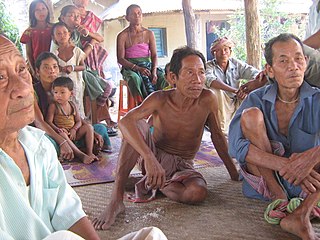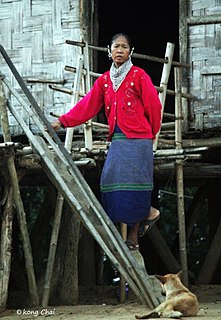Related Research Articles
Kokborok (Tripuri/Tiprakok) is the main native language of the Tripuri people of the Indian state of Tripura and neighbouring areas of Bangladesh. Its name comes from kok meaning "verbal" and borok meaning "people" or "human". Kokborok or Tripuri is one of the ancient language of North East India.
The Tripuri are an ethnic group originating in the Indian state of Tripura. They are the inhabitants of the Twipra/Tripura Kingdom in North-East India and Bangladesh. The Tripuri people through the Manikya dynasty ruled the Kingdom of Tripura for many years until the kingdom joined the Indian Union on 15 October 1949. Under the presidency of Queen Kanchan Prava Devi, mother of Kirit Bikram Kishore Deb Barman.
Kokborok, also known as Tripuri or Tipra, is the language of the original inhabitants of Tripura. It is an official language of Tripura, a small state of India.

Bodo-Kacharis are an anthropological and a linguistic group of ethnic groups living predominantly in the Northeast Indian states of Assam, Tripura & Meghalaya, that speak Assamese and Boro-Garo languages—some of who possibly have shared ancestries. Many of these peoples formed early states in the late Medieval era of Indian history and came under varying degrees of Sanskritisation. Many others were Hinduised under the influence of Ekasarana Dharma in the 17th century and adopted the Assamese language.
Debbarma is a generic term applied to a number of ethnic groups, predominantly in Tripura state, India and Bangladesh speaking Kokborok which is Tibeto-Burman languages.
Jamatia is one of the Tripuri clan of Tripura And it is the only Tripuri clan of Tripura with its own Customary Law in Practice. They mainly dwell in the West Tripura and the South Tripura districts. They speak the language Kokborok which is of Tibeto-Burmese origin. There were 74,949 Jamatia people as of the 2001 Census.

Koloi is one of the 21 scheduled tribes of Tripura state of India. They are mainly dwelling in the West Tripura districts. They speak the language Kokborok which is of Tibeto-Burmese origin.
Noatia is one of the 21 scheduled tribes of the Tripura state of India. The tribe mainly lives in the hills of Dhalai and the North Tripura districts of the Tripura state of India. They speak the Noatia dialect of Kokborok which is of Tibeto-Burmese origin.

Uchoi is one of the 21 scheduled tribes of Tripura state of India. They are mainly dwelling in the Gomati and the South Tripura districts of Tripura state of India. They speak the language Kokborok which is of Tibeto-Burmese and their dialect is similar with Reang tribe. According to the folk tales, Uchois and Reangs are of same origin.
Hrangkhawl is one of the 21 scheduled tribes of Tripura state of India. They are mainly dwelling in the Teliamura sub-division of West Tripura and the Ambassa sub-division of Dhalai districts. Hrangkhawls are also found in the North Cachar Hills of Dima Hasao district, Assam. They speak the Hrangkhawl dialect of Kuki language which is of Tibeto-Burmese origin.
Chakma language is an Indo-Aryan language spoken by the Chakma and Daingnet people. The language has common features with other languages in the region like the Chittagonian dialect of Bengali language, Tanchangya, Arakanese and others. It is spoken by nearly 320,000 people in southeast Bangladesh in Chittagong Hill Tracts, and another 230,000 in India, including 96,972 in Mizoram, Tripura and Arunachal Pradesh. It is written using the Chakma script, which is also called Ajhā pāṭh, sometimes romanised Ojhopath. Literacy in Chakma script is low.
The indigenous people of Bangladesh refer to ethnic minorities in Chittagong Hill Tracts (southeastern), Sylhet Division (northeastern), Rajshahi Division (northwestern), and Mymensingh District (north-central) areas of the country. The total population of indigenous ethnic minorities in Bangladesh was estimated to be over 2 million in 2010. They are diverse ethnic communities including Tibeto-Burman, Austric and Dravidian people.

The national language and official language of Bangladesh is Bengali according to the third article of the Constitution of Bangladesh. With 98% of Bangladeshis fluent in Bengali as their first language, Bangladesh is the only monolingual country in South Asia. Bengali Language Implementation Act, 1987 made it mandatory to use Bengali in all government affairs except in the cases of foreign relations. According to a 2011 census, Bengali is predominantly spoken by 98% of the country's population and it also serves as the national language of the nation. The indigenous people of northern and southeastern Bangladesh speak a variety of native languages.
The Halam community are various tribes native to the state of Tripura and Assam, Mizoram in India. The name Halam was coined by the Tipra Maharaja. As per their oral tradition they called themselves "Riam", which literally means "Human being". And lyrically they also call themselves "Riamrai, Reivon, Longvon, Manyâ, Chepvon etc.". The Halam are further divided into 12 sub-tribes, namely Chorei, Molsom, Hrangkhol, Kaipeng, Kalai, Ranglong, Khelma Saimâr, Bongcher, Korbwng, Dab and Rupini.
The Boro–Garo languages are a branch of Sino-Tibetan languages, spoken primarily in Northeast India and parts of Bangladesh.
The Boroic languages are a group of Sino-Tibetan languages spoken in northeastern India. They are:

Culture of Tripura is distinct and a bit similar to other people of Northeast India. However like Assam, Manipur, Burma and Southeast Asia culture of Tripura is characterized in small portion living in plain areas notably the Tripuri culture. Tripura is a state in North East India. In the 2001 census of India, Bengalis represented almost 70% of the population and the Tripuri population comprised 30% of Tripura's population. The Tripuri population comprises some clans and ethnic groups with diverse languages and cultures. The largest native group was the Tripuri who had a population of 543,848 in 2001 census, representing 16.99% of the state population and 54.7% of the scheduled tribe population. The other group of people in order of decreasing population were Chakma (6.5%), Halam (4.8%), Mog (3.1%), Munda, Kuki tribes and Garo Hajong. Bengali is the most spoken language, due to the dominance of Bengali people in the state. Kokborok (Tripuri/Tiprakok) is a common language among Tripuris and lingua franca among tribes. Several other languages belonging to Indo-European and Sino-Tibetan families are spoken by the different tribe

The Tibeto-Burman languages are the non-Sinitic members of the Sino-Tibetan language family, over 400 of which are spoken throughout the highlands of Southeast Asia as well as certain parts of East Asia and South Asia. Around 60 million people speak Tibeto-Burman languages, around half of whom speak Burmese, and 13% of whom speak Tibetic languages. The name derives from the most widely spoken of these languages, namely Burmese and the Tibetic languages . These languages also have extensive literary traditions, dating from the 12th and 7th centuries respectively. Most of the other languages are spoken by much smaller communities, and many of them have not been described in detail.

Bangladeshis are the citizens of Bangladesh, a South Asian country centered on the transnational historical region of Bengal along the eponymous bay.
Languages of Tripura, a state in the Northeast India, include Bengali and Kokborok as official language, and many other minority languages. As in the rest of India, English is used for official purpose. Bengali is the most spoken language, due to the predominance of Bengali people in the state. Kokborok is a prominent language among the tribals.
References
- ↑ "tripura state prepares to observe kokborok day". Archived from the original on 1 February 2015. Retrieved 1 February 2015.
- ↑ Ali, Syed Sajjad (20 January 2015). "Kokborok day observed". The Hindu. Retrieved 31 January 2018.
- ↑ "Language Wing - TTAADC" (PDF). Archived from the original (PDF) on 22 December 2014. Retrieved 1 February 2015.